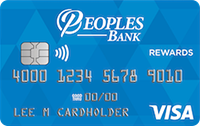Posted On: March 12, 2019 by Peoples Bank in:

Loans can be a nuisance, but they don’t have to be. Maybe you’re struggling with high monthly payments. Or maybe you believe you can get a lower interest rate. There are ways to remedy your struggles. Of course, paying your loans off as soon as possible is the best solution, but you can also refinance and find better terms.
Refinancing essentially means replacing one loan obligation with another under different — hopefully better — terms. The process can potentially find you a better interest rate and monthly payment.
Here are three common questions we receive about refinancing, and how you can go through the process.
What kinds of loans can I refinance?
Any type of loan can be refinanced, but the level of complexity varies.
For example, mortgages are much more complicated because of their size, length and options. An auto loan or personal loan will be much easier, especially if they are shorter and smaller in sum. Student loans are relatively easy to work with and are a popular option for people who have built up strong credit a few years after graduation.
You can also use refinancing to consolidate debt. This works well with student loans in particular, where there can be multiple debts in multiple places.
Should I refinance?
This is where every discussion starts. You’ll need to weigh whether it’s worth refinancing your loan or sticking with what you have.
An improved credit score is one of the biggest reasons for refinancing. At the time the loan was originated, you may have had little or poor credit history. Now, with an improved score, you can potentially find better rates, meaning a smaller payment over the remaining life of the loan. It’s important to remember that interest rates aren’t everything, though. There are many different factors that come into play.
“A lot of times, people are sensitive to their interest rates,” said Melany Jennings, vice president, loan officer and branch manager in Ogden. “But sometimes it’s not the most important factor. The question should be what is your goal with a refinance?”
Refinancing can also adjust your monthly payments in order to pay off a loan faster or to lower monthly payments.
On the other hand, the loan balance and term length may just be too small or too short to make any refinance necessary. If you’re looking for the lowest rate, a three-year auto loan with a 2.99 percent interest rate may not qualify you for refinancing. But if you do want to adjust the length on that loan, refinancing can help.
The main purpose for refinancing is to save money. Use the many online refinance calculator tools to see if this option will work for you. Or sit down with a loan officer at your local bank.
How do I refinance?
Your local bank will be more than happy to help you through the process, but there are a few things to keep in mind before you pick up the phone or walk into an office.
Know your end goal, whether it be lowering your interest rate, tapping into home equity or extending the loan term. You’ll also have to disclose your current loan terms — interest rate, the length and the balance — to help the bank determine what benefits refinancing can offer.
“Really, it’s a story,” Jennings said. “Why are they here? What do they really want to do with it?”
Just as with any other loan, the bank will ask for your personal information and determine your interest rate. Depending on your goals, the lender can work with you and make adjustments to fit your monthly budget. It also doesn’t hurt to shop around to find the best rates and terms possible.
After you’ve received the new loan, you’ll need to pay off the old loan. This won’t be an issue if you have worked with the same lender, but if you’ve shopped around, ensure the old loan is completely closed before moving forward.




